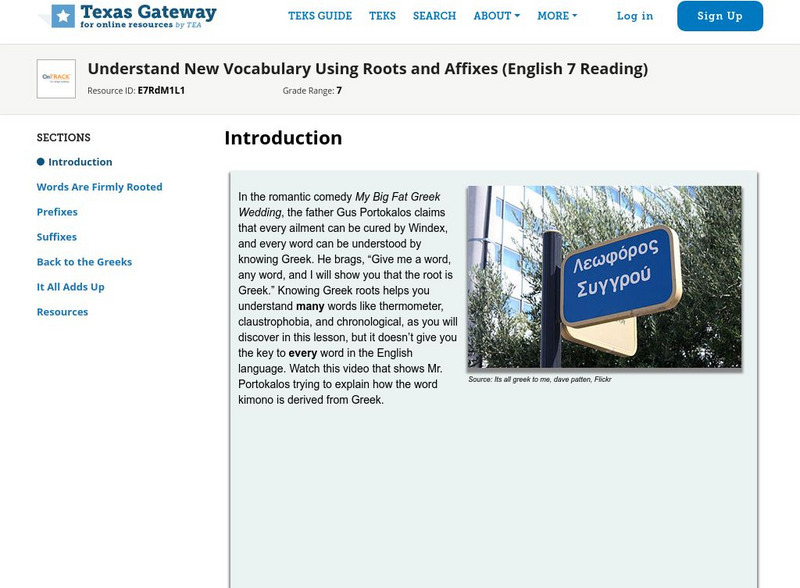Curated OER
Decoding Strategies
Students practice using context clues to decode the meanings of unfamiliar words. In this vocabulary skills instructional activity, students follow the provided instructions to complete graphic organizers that enable them to decode words...
Curated OER
AN INTERNATIONAL MENU
Studentsl expand vocabulary through word study, literature and class discussion (e.g. word origins, roots and affixes, meaning in context, levels of usage, etc.). They recognize food-related words that have entered the English language...
Curated OER
Vocabulary Building Cards
Students select vocabulary words from their reading each week then complete a card for each word which includes definition, source and a sample sentence. They share their cards with the class and complete vocabulary building cards...
Curated OER
Practice Book O
Whether you need resources for reading comprehension, literary analysis, phonics, vocabulary, or text features, an extensive packet of worksheets is sure to fit your needs. Based on a fifth-grade curriculum but applicable to any level of...
Curated OER
Utilizing Vocabulary
You can use flip books as a means to practice and apply new vocabulary in any content area.
Curated OER
Using Context
Teams practice decoding and using context strategies to determine the meanings of unfamiliar words. After verifying the meanings of words through the use of dictionaries, the Internet, thesauruses, and other sources, learners write the...
Curated OER
Split Suffixes
Make new words by adding suffixes to word beginnings. There are four suffixes here: -ible, -able, -ive, and -ion. After using them to complete five given words, they use their vocabulary skills to apply the suffixes to...
Curated OER
Context Clues
Young scholars practice identifying the meanings of unknown words using context clues. In this vocabulary activity, students read sentences which contain an unknown words. They will use the context of the sentence to determine the...
Hawaiʻi State Department of Education
Making Dances From Stories
After reading a short story, learners will create dances that show homophones and verbs. Their dance sequences involve three verbs and transition movements in between each verb. Tip: Have the class dance out the sequence of events from...
Curated OER
Using a Dictionary
When do we use dictionaries? Provide this dictionary scavenger hunt for your youngsters. Third and fourth graders search for words, recording the number of syllables or definition for a variety of words. Get your class using dictionaries...
Alabama Learning Exchange
Echolocation Stations: Exploring Sound
Fourth graders explore the concept of echolocation during a unit on whales. They listen to the book and watch the Reading Rainbow video for "Humphrey: The Wayward Whale," explore various websites, and conduct experiments to demonstrate...
Curated OER
Food Pyramid Menu
Students analyze the food pyramid. In this food pyramid instructional activity, students evaluate their nutritional needs. Students record their eating habits and determine if their food choices were healthy.
Curated OER
Using A Dictionary
Students explore English by completing a word definitions worksheet. In this dictionary instructional activity, students practice locating a list of vocabulary terms in a "Dictionary Race." Students complete a worksheet based upon word...
Curated OER
Name That Place: Cultural Place Names in the United States
Students examine the origin of the people that settled in the United States. In this United States History lesson, students work in small groups to complete several activities that explore early settlement, such as a worksheet, a...
Curated OER
Centipede or Millipede?
Pupils discuss millipedes and centipedes in terms of their classification as arthropod. Using a diagram, students categorize and compare and contrast the characteristics of millipedes and centipedes based on their discussion of...
Texas Education Agency
Texas Gateway: Reading: Understand New Vocabulary Using Roots and Affixes
In this lesson, you will learn about two kinds of affixes - prefix and suffix. Prefixes are attached, before a root or base word, and suffixes to the end of a word. You'll learn how all three word parts are keys to unlocking the meanings...
Texas Education Agency
Texas Gateway: Understand New Vocabulary Using Roots and Affixes
Learn how to determine the meaning of grade-level academic English words derived from Latin, Greek, or other linguistic roots and affixes.
Texas Education Agency
Texas Gateway: Understand New Vocabulary Using Roots and Affixes
Determine the meaning of grade-level academic English words derived from Latin, Greek, or other linguistic roots and affixes.
Texas Education Agency
Texas Gateway: Understand New Vocabulary Using Roots and Affixes
Determine the meaning of grade-level academic English words derived from Latin, Greek, or other linguistic roots and affixes.
Texas Education Agency
Texas Gateway: Linguistic Roots and Affixes (English Ii Reading)
[Accessible by TX Educators. Free Registration/Login Required] You will be able to recognize linguistic roots and affixes to use in determining the meaning of academic English word and in other content areas.
Texas Education Agency
Texas Gateway: Understand New Vocabulary Using Roots and Affixes
This lesson focuses on learning new vocabulary by using prefixes, suffixes, and roots. It includes a brief history of affixes and learning exercises.
Texas Education Agency
Texas Gateway: Understand New Vocabulary Using Roots and Affixes
You will learn how to determine the meaning of grade-level academic English words derived from Latin, Greek, or other linguistic roots and affixes.
Reading Rockets
Reading Rockets: Reading Topics a to Z: Root Words, Roots, and Affixes
An introduction to using word parts to improve vocabulary skills. Includes charts of common Greek and Latin roots as well as common prefixes and suffixes and their meanings. Each of the four charts can be downloaded.























